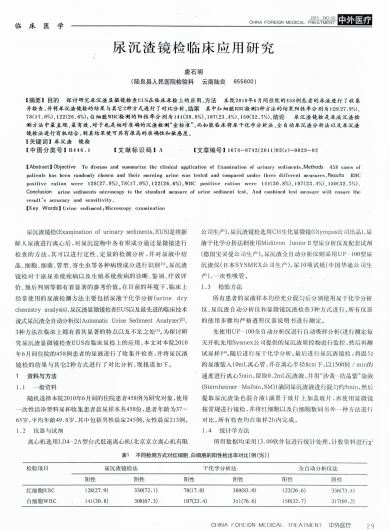尿沉渣镜检临床应用研究
 |
| 第1页 |
参见附件。
【摘要】目的探讨研究尿沉渣显微镜检查EUS在临床尿检上的应用。方法本院2010年6月间住院的458例患者的尿液进行了收集并检查,并将尿沉渣镜检的结果与其它2种方式进行了对比分析。结果其中红细胞RBC检测3种方法的结果阳性率分别为128(27.9%)、78(17.0%)、122(26.6%);白细胞WBC检测的阳性率分别为141(30.8%)、107(23.4%)、150(32.7%)。结论尿沉渣镜检是尿液沉渣检测方法中最直观、最有效,对于也是相对准确的沉渣检测“金标准”。而如能临床将尿干化学分析法、全自动尿沉渣分析法以及尿沉渣镜检法进行有机结合,则其结果便可具有很高的准确性和敏感度。
【关键词】 尿沉渣 镜检
【中图分类号】 R446.1【文献标识码】 A【文章编号】 1674-0742(2011)02(c)-0029-02
【Abstract】 ObjectiveTo discuss and summarize the clinical application of Examination of urinary sediments.Methods458 cases of patients has been randomly chosen and their morning urine was tested and compared under three different measures.ResultsRBC positive ration were 128(27.9%)、78(17.0%)、122(26.6%),WBC positive ration were 141(30.8%)、107(23.4%)、150(32.7%). Conclusionurine sediments microscopy is the standard measure of urine sediment test. And combined test measure will ensure the result’s accuracy and sensitivity.
【Key Words】 Urine sediment;Microscopy examination
尿沉渣镜检(Examination of urinary sediments,EUS)是将新鲜人尿液进行离心后,对尿沉淀物中各有形成分通过显微镜进行检查的方法,其可以进行定性、定量的检测分析,并对尿液中结晶、细胞、细菌、管型、寄生虫等各种病理成分进行识别[1] ......
您现在查看是摘要介绍页,详见PDF附件。